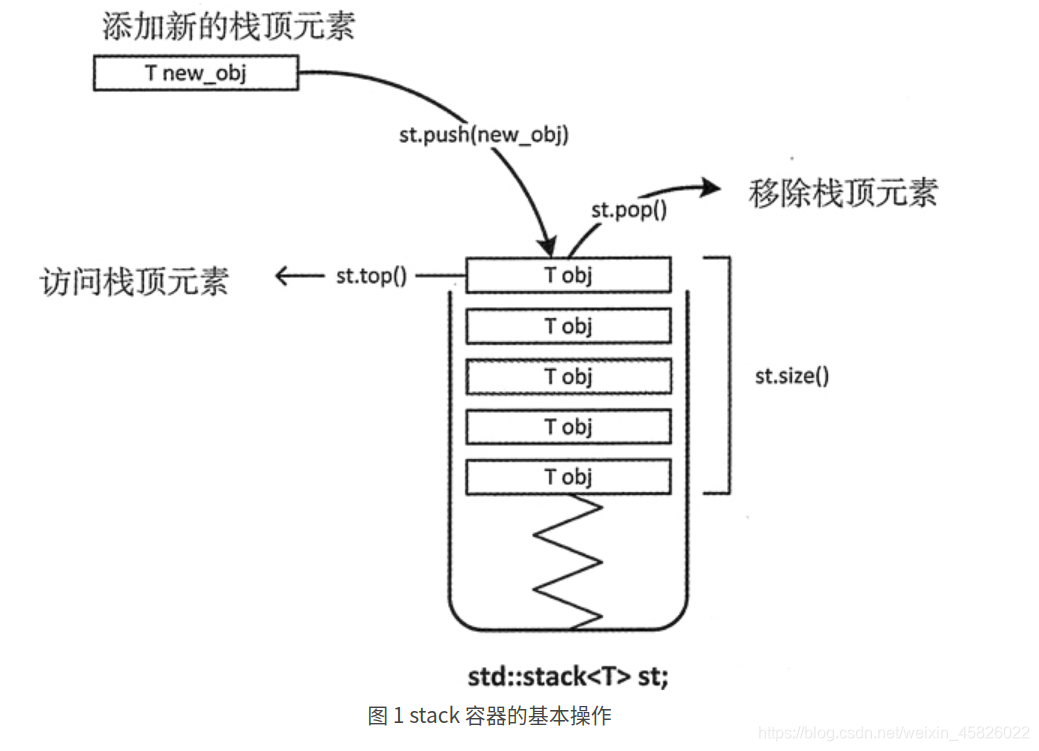更多关于STL文章——STL学习笔记
容器适配器
stack
Class stack<> 实现出一个 stack(也称为LIFO,后进先出)。你可以使用 push() 将任意数量的元素放入 stack,也可以使用 pop() 将元素依其插入的相反次序从容器中移出(此即所谓“后进先出[LIFO]”)。
class stack 定义如下:
namespace std{
template <typename T, typename Container = deque<T>>
class stack;
}
第一个 template 参数代表元素类型。带有默认值的第二个 template 参数用来定义 stack 内部存放元素的实际容器,默认为 deque。之所以选择 deque 而非 vector ,是因为 deque 移除元素时会释放内存,并且不必在重分配,并且不必在重分配时复制全部元素。
Stack 的实现中只是很单纯地把各项操作转化为内部容器的对应调用。你可以使用任何sequence容器支持 stack,只要它们提供以下成员函数:back()、push_back() 和 pop_back()。
template<typename Tp, typename Sequence = deque<Tp> >
class stack{
public:
typedef typename Sequence::value_type value_type;
typedef typename Sequence::reference reference;
typedef typename Sequence::const_reference const_reference;
typedef typename Sequence::size_type size_type;
typedef Sequence container_type;
}
| 类型名称 | 定义 |
|---|---|
| value_type | 元素的类型 |
| reference | 用以指向元素之reference类型 |
| const_reference | 用以指向只读元素之reference类型 |
| size_type | 不带正负号的整数类型,用来表现大小 |
| container_type | 内部容器的类型 |
- 构造
explicit stack (const container_type& ctnr);
//构造一个stack,其内部容器被初始化为ctnr的副本。
explicit stack (container_type&& ctnr = container_type());
//构造一个stack,其内部容器通过移动构造来获取ctnr的值。
template <class Alloc> explicit stack (const Alloc& alloc);
//构造一个stack,其内部容器使用alloc作为参数构造。
template <class Alloc> stack (const container_type& ctnr, const Alloc& alloc);
//构造一个stack,其内部容器使用cntr和alloc作为参数构造。
template <class Alloc> stack (container_type&& ctnr, const Alloc& alloc);
//同上,移动构造
template <class Alloc> stack (const stack& x, const Alloc& alloc);
//构造一个stack,其内部容器使用x的内部容器作为第一个参数,而alloc作为第二个来构造。
template <class Alloc> stack (stack&& x, const Alloc& alloc);
//同上,移动构造
#include<iostream>
#include<stack>
#include<list>
#include<deque>
using namespace std;
int main()
{
deque<int> mydeck (3,100); //创建一个deque含3个100
list<int> mylist (2,200); //创建一个list含2个200
stack<int> first; //创建一个空的堆栈
stack<int> second (mydeck); //用mydeck的拷贝作为堆栈的初始值
//第二个参数模板默认即为 deque,因此可以不写。
stack<int,list<int>> third; //空堆栈,列表作为底层容器
stack<int,list<int>> fourth (mylist); //用mylist的拷贝作为堆栈的初始值
cout << "size of first: " << first.size() << endl;
cout << "size of second: " << second.size() << endl;
cout << "size of third: " << third.size() << endl;
cout << "size of fourth: " << fourth.size() << endl;
return 0;
}
结果为:
size of first: 0
size of second: 3
size of third: 0
size of fourth: 2
下面为其成员函数:
- empty
判断容器是否为空
bool empty() const;
- size
返回当前的元素个数
size_type size() const;
- top
返回最后一个安插的元素
reference& top();
const_reference& top() const;
- push
安插一个元素
void push (const value_type& val);
void push (value_type&& val);
- emplace
构造与安插元素
template <class… Args> void emplace (Args&&… args);
- pop
移除容器内的下一个元素
void pop();
- swap
交换两个容器的内容
void swap (stack& x);

图片来源:c语言中文网
一个stack的使用例子
题目来源:洛谷P1739
题目描述
假设一个表达式有英文字母(小写)、运算符(+,—,*,/)和左右小(圆)括号构成,以“@”作为表达式的结束符。请编写一个程序检查表达式中的左右圆括号是否匹配,若匹配,则返回“YES”;否则返回“NO”。表达式长度小于255,左圆括号少于20个。
输入格式
一行:表达式
输出格式
一行:“YES” 或“NO”
输入输出样例
输入 #1
2*(x+y)/(1-x)@
输出 #1
YES
输入 #2
(25+x)(a(a+b+b)@
输出 #2
NO
说明/提示
表达式长度小于255,左圆括号少于20个
#include<iostream>
#include<stack>
#include<string>
using namespace std;
int main()
{
string str;
getline(cin,str);
stack<char> buf;
for(auto& i:str){
if(i=='(') //如果等于 ( 进栈
buf.push(i);
else if(i==')'){ //如果等于 ) 进行判断
if(!buf.empty()) //如果栈不为空,将最后一个进栈的 ( 弹出,说明该括号已经匹配
buf.pop();
else{ //如果此时栈为空,说明不匹配,直接输出NO 退出
cout<<"NO"<<endl;
return 0;
}
}
}
if(buf.empty()) //如果最后栈为空 说明全部匹配,输出 YES
cout<<"YES"<<endl;
else //如果最后栈里面还有 ( 说明未匹配,输出 NO
cout<<"NO"<<endl;
return 0;
}
